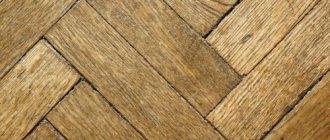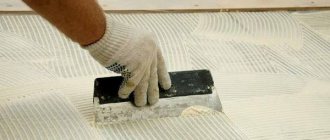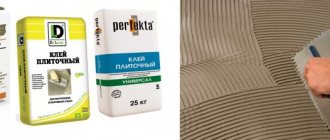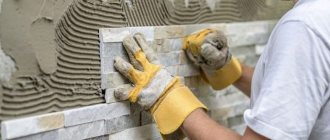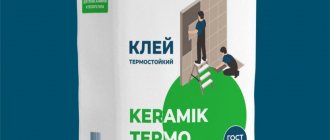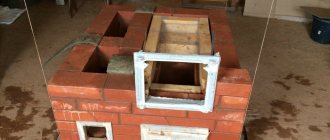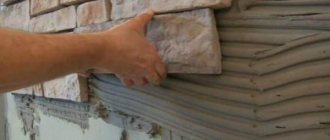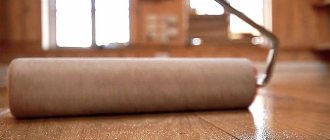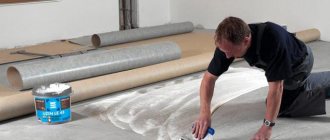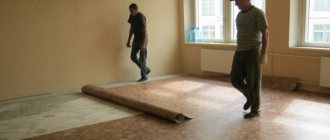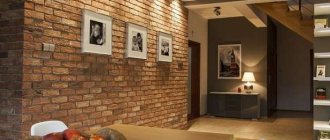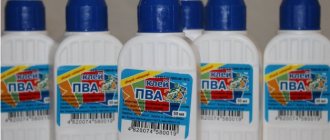The need to choose the right adhesive for parquet on a concrete screed appears quite often in the process of repair and construction work. This option for installing floor coverings makes it possible to create a durable and reliable floor, but only if the correct composition for fastening is selected and the technology in the process is followed.
If the glue is chosen incorrectly or some of the important requirements are ignored during the work process, the consequences can be disastrous: from the unpleasant creaking of the lamellas while walking to the complete peeling of the floor from the base. In any case, such troubles lead to a decrease in operating comfort and a significant reduction in the service life of the coating.
Therefore, before you begin choosing compositions and installing parquet, you need to carefully study and think about everything.
Requirements for parquet adhesive
In order for parquet installation to be high-quality and durable, the glue must be:
- Low shrinkage. If the glue sag significantly when drying, the parquet will begin to creak or dry out.
- Elastic. It should give the parquet board moderate flexibility. If this is not the case, then the floor will swell with changes in temperature and humidity.
- Ecologically pure. Toxic mixtures can harm people who live or work in the area.
- Low moisture content. Otherwise, the board will swell and become deformed.
- Long lasting. The service life of the adhesive should coincide with the lifespan of the parquet.
We should not forget about convenience when working. The composition should be easily applied to the surface of the base, and should not leave stains if accidentally applied to the front of the board.
How to properly attach a board to a screed with glue
In order for the parquet installation to be carried out correctly, the coating to serve for a long time and with high quality, it is necessary to carry out the installation correctly. First, it is advisable to correctly calculate the material for the floor with a margin of at least 3-5% when laying on deck.
The material is delivered to the site at least 2 days in advance (preferably more), without unpacking, allowing the tree to adapt to the conditions. The glue is selected in accordance with the above characteristics and tips.
Tools for laying parquet with glue: hammer, hacksaw, hammer drill, tape measure, limiting wedges, a regular notched trowel (even better than several), tamping block.
Necessary materials: parquet, plywood (if you plan to make a backing), nails, adhesive sealant, parquet glue.
The main stages of laying parquet with glue (concrete with plywood backing):
- An adhesive composition is applied to a clean, even, dry concrete screed with a spatula, and sheets of plywood are mounted on top, which are additionally secured with screws at 32 points. You need to move from the center to the exit, the sheets are mounted staggered, all voids are filled with sealant, and gaps of 5 millimeters are left near the walls.
- The first row of parquet is glued using limiting wedges with gaps from the wall of 10 millimeters. The glue is applied to the plywood and the ends of the parquet lamellas; additionally, the boards are fastened together with nails. To achieve maximum adhesion, the boards must be pressed firmly to the floor and excess glue must be removed.
- Each next row relative to the previous one is shifted by half the board. The evenness of the coating is checked by level.
- After installation is completed, the floor is not touched for the period indicated on the glue packaging. Only then can the base be sanded, varnished or treated with oil, etc.
Which glue is better
I want to choose the best composition that will last a long time. But the range of adhesives is represented by a large number of brands, and it is difficult to decide which will be better. You can narrow your search by determining which adhesive mixture is most suitable for parquet and subflooring.
One-component
One-component parquet adhesive is convenient because the package contains a ready-to-use product. It does not need to be further diluted, which saves time during installation. There are 2 types of one-component mixtures available:
- Water based glue. An environmentally friendly, inexpensive and convenient composition where the solvent is water. Dispersion adhesive is used if the width of the board is at least a centimeter and if the surface of the parquet plank adjacent to the base is not sanded. You cannot glue parquet elements made of wood that absorbs moisture: ash, alder, beech, fruit trees. It is also prohibited to use a water-dispersion mixture for laying parquet in damp or unheated rooms - the parquet will absorb water, swell and deform.
- On solvents. Solvent-based adhesive solutions contain no water and are suitable for any wood. When choosing adhesive for parquet under plywood, you should give preference to a water-free mixture. The composition provides high adhesion to the surface, so the parquet can withstand large mechanical loads and temperature changes. Recommended for wood species prone to moisture absorption.
When compared, it may seem that formulations with solvents are better, but this is not always the case. Adhesive mixtures of this group are toxic and have a pungent odor. When working with them, you must use protective masks to protect your lungs. In addition, solvents are flammable; mixtures cannot be used when laying parquet near fire sources.
Two-component
A quick-drying, elastic and durable two-component parquet adhesive suitable for all types of wood and can be used on any substrate. The product does not contain solvents, and polymerization occurs by mixing the hardener and the polymer base. Craftsmen often choose to lay parquet boards:
- Polyurethane. Two-component polyurethane adhesive increases the strength of parquet by 30-40%. Does not contain toxic components.
- Polyurethane-epoxy. Gives less additional strength (15-20%) and has an unpleasant odor before drying. It is cheaper than polyurethane.
Two-component products have only one drawback - high cost. But this compensates for the almost complete absence of shrinkage and high strength. Parquet floors made with polymer mixtures will last a long time.
Other formulations
Other groups of products can also be used for gluing parquet. Let's look at what other glue you can use:
- Universal. Made from rubber or natural resins. Hardens quickly. Rubber adhesive has low adhesion. If you plan to use this mixture, you need to make a special screed and prime the base well.
- Alcoholic. The alcohol-based product is odorless, easy to use and dries quickly. Good adhesive for plywood and moisture-absorbing wood. Can be used for laying on heated floors.
- PVA. The adhesive mixture based on polyvinyl acetate dispersion is non-toxic and has high moisture and heat resistance. Used for parquet made of wood of all species. Suitable for laying decor on any base.
In order for the parquet to last as long as possible, you should take the choice of adhesive seriously.
Having decided on what basis to buy a product for laying parquet planks, you can move on to choosing an adhesive.
Preparing the base
Regardless of the chosen installation method, parquet requires a smooth and thoroughly dried base. The permissible humidity of a concrete subfloor is up to 5%, the height difference is up to 2 mm per 2 m. For unevenness up to 2 cm, self-leveling mixtures are used; for larger differences, a screed is used. It should be dry, strong, without cracks, voids, potholes and not crumble when scratched with a nail. It is also necessary to clean it from dirt and dust.
The use of a substrate and floating installation technology does not reduce the requirements for the base. If it is not level enough, the risk of creaks, cracks and deformation of the parquet floor subsequently increases. If you lay it on an insufficiently dried screed, this will lead to moisture in the wood, swelling of the parquet and the appearance of cracks.
Review of popular brands
Let's consider the popular tools that the construction market offers:
- Artelit. Rubber based. Suitable for gluing parquet flooring to any substrate. Can be used for heated floors and on surfaces where there is vibration.
- Moment. Bonds all types of parquet finishes: plywood, wood, laminated coverings. Quick-drying, durable, moisture-resistant.
- Bostic Tarbicol. Water-dispersible vinyl. Tarbicol sets quickly. Designed for gluing small-sized parquet tiles with a rough working surface.
- Coswick. Anhydrous elastic polyurethane composition. Universal, suitable for all types of coatings.
- Kiilto. On a PVA basis. Non-flammable, environmentally friendly, hardens quickly. Kiilto is used for a piece set of small parquet floors.
- Craft. Two-component, durable. Can be used for laying massive elements.
- Super-Grip. Epoxy adhesive that can withstand large temperature changes. Glues any materials.
- KS. Universal with mineral additives. Non-toxic, non-flammable. Connects any base.
- Murexin. Two-component polyurethane. Reliably glues any coating.
- Slim. Designed for gluing all types of parquet boards to concrete or building slabs. Two-component, durable.
- Axton. Water dispersion for parquet. Eco-friendly, safe for health. Glues firmly.
- Bona. Polyurethane, two-component, universal.
- Stauf. A line of adhesives based on alcohol, water or polyurethane.
- Repox. Epoxy-polyurethane, designed for various substrates. Has a good adhesion rate.
- Adesiv pelpren. Two-component parquet adhesive. Using the product, you can lay elements of any size.
- Eurocol Frodo 148. Reactive adhesive for mounting any board on all types of substrates.
Having familiarized yourself with the assortment of construction companies, it is worth considering another nuance of choice - the characteristics of the bases for gluing.
Floating method
Laying parquet without glue is suitable for tiles with a tongue-and-groove system and allows you to lay them with less effort. The parquet flooring is laid on a backing made of cork or other material with high sound and thermal insulation. The dies are connected to each other using locks, sometimes with vinyl glue (to prevent possible squeaks). In technology, this method is similar to laying laminate flooring.
During seasonal changes in humidity, dies laid using the floating method expand and contract freely, without tension between the wooden covering and the adhesive layer. The main thing is to provide technological clearances during their installation. The canvas is not fixed to the base, so if necessary, it can be disassembled and re-laid in another room.
The choice of glue depending on the coating
Before purchasing glue, you need to evaluate the type, nature of the work and size of the materials:
- Laying plywood on concrete. Adhesive for parquet on concrete screed must be selected with high adhesion and elasticity. Solvent-based or two-component formulations are suitable.
- Gluing solid boards. Mixtures with rubber or two-component ones are recommended.
- Piece set. For block parquet, regardless of the nature of the base, a composition with PVA is suitable.
Taking into account the characteristics of the coating and the characteristics of the floor base, you can choose the optimal adhesive composition that will ensure the strength and durability of the glued parquet.
Installation method without plywood: features
Block parquet and boards can be attached directly to concrete. This way, significant savings in money, time, and effort are achieved. Typically, plywood was used earlier, when there were no strong adhesives; floors were made on wooden joists and floors with bitumen backfill and hardboard on top.
Block parquet can be easily laid on concrete without gaps or cracks. After finishing, the floor is reliable and smooth. The boards are attached to the concrete base with glue, then the parquet is sanded with a special machine or manually, the cracks are sealed with sealant, and sanded again. The finished surface is primed, coated with oil or varnish.
Varnish coating is considered a higher priority, as it protects the floor surface from mechanical damage and moisture, making it durable and aesthetically pleasing.
A solid board is not always ideal in terms of parameters and geometry, so if you install it without plywood, you need to fix it with nails and tighten it.
Additional tips for choosing parquet adhesive
When choosing a composition, you additionally need to take into account the load on the floors:
- Huge pressure. A two-component adhesive with high adhesion is optimal.
- Dimensions of parquet planks. A wide parquet board adheres well to the main surface, but under load, lateral tearing is possible. You need glue with high elasticity, preferably polyurethane based. For small slats, a rubber compound is suitable.
When laying parquet in rooms with a heavy load on the floor, you do not need to save on building materials. By purchasing compounds at a discount, you can get fake adhesives that do not have the necessary strength characteristics. This will certainly affect the quality of the parquet installation.
Difficulty of choice
As practice shows, the average buyer is unlikely to be able to independently and without proper experience correctly select one or another adhesive for a specific type of parquet. The adhesive composition must meet a number of criteria, on which the strength, reliability and durability of the laid parquet board will depend. These criteria may include:
- Working convenience - the mixture should be conveniently applied with a spatula, not contain extremely harmful and super-toxic elements, and not harden too quickly for the purpose of possible adjustment of the position of the board (except for two-component samples, the structure of which contains a hardener).
- Structural uniformity - upon completion of application, the resulting layer should not contain air bubbles, which could negatively affect the quality of the gluing. The adhesive reef should hold its shape and not spread, thus preventing possible shrinkage, subsidence and stress in certain areas of the floor covering. All this directly affects the initial strength and is important for the initial stage of adhesion.
- The “life” period of the glue is an extremely important criterion, because some types of glue can lose their performance characteristics after just a year. When using cheap samples, it is possible for the seams to diverge or even for the parquet to lag behind the base. Unnecessary squeaks may also occur.
- Environmental properties - the selected composition must have an appropriate certificate recognized by the Russian state. This will ensure that such glue is harmless to humans after it has completely dried (some release of toxic substances is still allowed during the process of working with individual samples).
- Strength characteristics are another important criterion. Installed parquet or parquet boards are still a wooden material capable of accumulating moisture, as a result of which it is susceptible to expansion and deformation. Only high-quality glue can prevent moisture from penetrating into the wood structure, which will significantly increase its strength properties.
Is it necessary to prime the surface?
Despite the fact that some types of adhesives indicate that they can be used without priming, this stage of work should not be neglected. Application of primer will provide:
- binding of dust particles remaining on the surface;
- uniform absorption of glue;
- adhesive strength.
A double primer is applied using a roller. After applying the first layer, you need to wait for the composition to dry and repeat the procedure. Installing a parquet board on a primed base will be stronger.
conclusions
Which method to choose - adhesive or floating - depends on the area of the room, the thickness of the parquet flooring, the presence of a floor heating system, existing preferences and other factors. Regardless of the chosen installation method, it is necessary to carefully prepare the base and strictly follow the installation technology at all its stages. The slightest failure to comply with installation rules leads to deformation of the coating and other problems during its operation.
When choosing an adhesive technology, the base must be stationary, the glue must be elastic, and its application must be uniform, of the recommended thickness, without voids. When using inelastic adhesive, seasonal changes in humidity cause tension between the parquet flooring and the adhesive layer. As a result, the dies may break or come off. To avoid such defects, it is better to entrust the selection of glue and installation of parquet flooring to experienced installers.
Basic rules for laying parquet boards
Before laying parquet flooring, you need to check the humidity and temperature of the concrete screed. It is better to do this using a special device. Particular attention should be paid to measurements in corners where there is high humidity.
If you don’t have the device, then you should focus on the approximate hardening time of the concrete – about 2 weeks. The humidity level required to continue finishing work should not exceed 5%.
Glue mounting method
Laying this way is quite reliable. You just need to prepare a large notched trowel and a small tool. Laying algorithm:
- parquet glue (slightly larger than the size of the board) is applied to the screed or other base that has dried after the primer with a ridge spatula;
- parquet is laid on the surface coated with adhesive and lightly fixed with light pressure (excess protruding from under the plank is immediately removed).
If the parquet slats are small, then it is allowed to lay out 3-4 parts of the pattern at once.
Option without rigid fixation
No glue is used. The joints of parquet flooring are connected using a locking system:
- a backing is laid on the floor (the joints of the material are secured with tape);
- lay out the first lamella with its upper part facing the wall;
- lay the boards parallel in a row, lightly tapping them with a wooden hammer;
- the next row of parallel elements is laid with an offset of ½ lamella.
Fixation of parts is strong. After completing the last row, you can walk on the parquet.
Using additional fasteners
Used when laying thick parquet flooring:
- parquet tiles are laid on glue, fastened with locks;
- A self-tapping screw is screwed in every 30-35 cm along the surface of the coating.
This fastening method is characterized by increased strength.
How to lay parquet on a concrete floor
The lamellas are laid on the concrete screed in the same way as on other surfaces. But here you need to take into account several nuances:
- lay the elements on a durable cement screed;
- before laying, check the moisture content of the concrete (no more than 5%);
- glue for parquet boards on screed must be selected with high adhesive properties.
Laying a parquet floor yourself is not difficult. But to ensure the strength and durability of the decorative coating, you need to select the appropriate adhesive and prepare the base.
Laying parquet: method without plywood
Plywood is not always used as a substrate. Often the boards are attached directly to concrete, leveled and prepared (dry, clean, perfectly level, without defects).
How to attach parquet to concrete:
- The concrete surface is primed.
- The planks of the first two rows are laid out as they plan to be installed, then the base is treated with glue with a notched trowel, and the first board is fastened at a distance of 6-12 millimeters from the wall. Then the next board is secured using a tamping block and pressed tightly to the floor.
- After laying the first row, the last die is trimmed and proceed to the next row.
- When performing installation, you must constantly use a level and ensure that there are no gaps between the rows and boards.
- When the installation is completed, all seams are treated with acrylic-based sealant and the floor is allowed to dry (2-5 days, depending on the glue), then the finishing is done.
Types of installation
You can lay parquet yourself:
- herringbone;
- in a take-off run, with a shift (a la “deck”);
- braided;
- squares from boards of different types of wood.
Herringbone
Laying herringbone parquet is more labor-intensive, but produces a finish with a beautiful and symmetrical pattern. This method of laying out allows for maximum unloading of individual dies due to a more uniform distribution of pressure from above, which reduces the risk of cracking of the coating at the seams.
Herringbone styling
Takeoff
The deck version is the easiest to install. It is allowed to move the dies by 1/4, 1/3 or 1/2 of their length, or even in a chaotic manner to form an asymmetrical pattern on the floor.
Laying out in a run
Network
The “braided” layout allows you to achieve a three-dimensional effect in the floor design. However, this method requires the use of parquet boards from at least two different types of wood, which usually leads to an increase in the cost of the coating. But the finished decor will look not just beautiful, but elegant and luxurious.
Braided laying
Squares
To lay parquet in squares, dies will also need to be taken from several rocks of different shades. This layout is distinguished by aesthetics and elegance, but is very demanding on the skill of the parquet floorer. If the “squares” of individual boards are made too large, they will visually put pressure and reduce the space of the room. And excessively small “squares” can get lost in the interior.
Laying in squares
